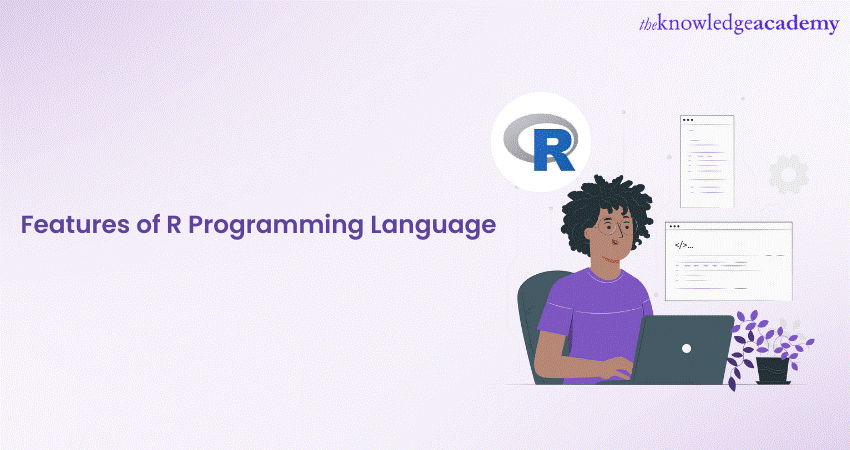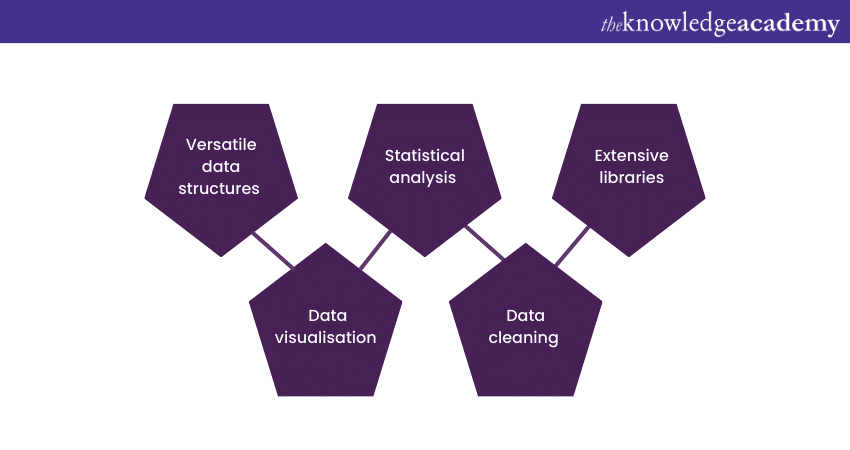We may not have the course you’re looking for. If you enquire or give us a call on +61 1-800-150644 and speak to our training experts, we may still be able to help with your training requirements.
Training Outcomes Within Your Budget!
We ensure quality, budget-alignment, and timely delivery by our expert instructors.

The R Programming Language is an extremely powerful tool used for statistical computing and data analysis. The Features of R Programming Language efficiently handle data and derive valuable data for informed decision-making. With its versatility and capabilities, R has become a preferred choice for data professionals and researchers across diverse domains.
According to PayScale, the average salary of a Data Analyst in the UK is £30,684 per year. If you are interested in pursuing a career as a Data Analyst, then Proficiency in R Programming language is vital. In this blog, you will learn about the basic and advanced Features of the R Programming language. Let's delve in deeper to learn more about it!
Table of Contents
1) What is R Programming Language?
2) Basic Features of R Programming Language
3) Advanced Features of R Programming Language
4) Conclusion
What is R Programming Language?
R is an open-source programming language and software environment widely used for statistical analysis, data visualisation, and machine learning. Its user-friendly interface and extensive libraries make it an excellent choice for researchers, statisticians, and data scientists.

Basic Features of R Programming Language
R Programming language is renowned for its exceptional capabilities, making it a preferred choice for data analysts, statisticians, and researchers. Let's dive into the fundamental features that set R apart and make it an indispensable tool in the world of data science.

Data handling
At the core of R's strength lies its efficient data handling capabilities. The language offers a diverse range of data structures, such as vectors, matrices, data frames, and lists, allowing users to store, manipulate, and analyse data effectively.
Vectors are one-dimensional arrays that can hold elements of the same data type. They form the building blocks of R and empower users to perform operations on multiple data points simultaneously. Understanding Operators in R Programming is essential for efficiently manipulating these vectors. Matrices, on the other hand, are two-dimensional arrays formed by combining multiple vectors of the same length. They are valuable for mathematical operations like matrix multiplication and inversion.
Data frames resemble tabular structures like spreadsheets, comprising rows and columns. They are widely used for data manipulation and analysis as they can store data of different types. Lists, on the other hand, are versatile data structures capable of containing elements of different types, including vectors, matrices, data frames, and even other lists. Lists provide flexibility in data organisation and are often used for complex data structures.
Data visualisation
Data visualisation is a pivotal aspect of data analysis, and this programming language offers a rich array of tools and libraries to create compelling and informative plots and charts. Among these, ggplot2 stands out as one of the most popular data visualisation libraries.
It provides a high-level grammar of graphics, enabling users to craft stunning visualisations with ease. With ggplot2, users can customise the appearance of plots, add annotations, and create complex visualisations without the need for intricate code.
In addition to ggplot2, R also supports plotly, a library that empowers users to create interactive and dynamic visualisations. For those wondering How Difficult is R Programming, working with libraries like plotly can enhance the learning experience and make it easier to understand and analyze complex datasets. These interactive plots allow users to explore the data further, providing a more engaging experience in understanding complex datasets.
Statistical Analysis
The backbone of this programming language capabilities lies in its robust statistical toolkit. It offers an extensive range of statistical functions and packages, making it the go-to language for researchers, statisticians, and analysts. From basic descriptive statistics to advanced inferential analysis, R can handle a variety of statistical tasks.
With functions like mean, median, standard deviation, and correlation, users can quickly summarise and explore their data. Additionally, it provides packages like stats and inferentialStats for conducting hypothesis testing, regression analysis, ANOVA, and other advanced statistical techniques.
Data cleaning and preprocessing
Before embarking on any analysis, it is essential to ensure that the data is clean and free from errors. This programming language offers a rich set of functions and packages for data cleaning and preprocessing tasks.
Functions like na.omit, na.fill, and complete.cases allow users to handle missing values effectively. Additionally, it provides functions for data transformation, such as scaling, centering, and normalisation, which are essential for many machine learning algorithms.
The basic features of R Programming, including robust data handling, powerful data visualisation, extensive statistical analysis capabilities, and efficient data cleaning and preprocessing, make it a versatile and indispensable tool for data professionals across various domains. Whether you are a beginner or an experienced data scientist, R's capabilities are sure to enhance your data exploration and analysis endeavours.
Unleash the true potential of statistical analysis with our R Programming Training. Sign up today!
Advanced Features of R Programming Language
R Programming language goes beyond its basic features and offers a rich set of advanced functionalities that cater to the needs of experienced data scientists and researchers. For those preparing for technical roles, understanding these advanced capabilities is crucial, and exploring common R Programming Interview Questions can be very helpful. Let's explore some of the more sophisticated capabilities that make it a preferred choice for complex data analysis and modelling.
Packages and libraries
One of the major strengths of R is its extensive collection of packages and libraries contributed by an active community of developers. These packages expand R's functionalities, covering a wide range of domains, including machine learning, time series analysis, natural language processing, and more.
The tidyverse is a famous collection of packages that includes ggplot2 for data visualisation, dplyr for data manipulation, tidyr for data tidying, and more. This cohesive ecosystem simplifies data workflows and enhances the overall coding experience.
Functional programming
This programming language supports functional programming paradigms, which is a powerful approach to writing code. Functions are inclusive of first-class objects, allowing them to be passed as arguments to other functions or returned as values. This enables users to write elegant and concise code, reducing redundancy and improving code readability.
By leveraging functional programming techniques, its users can create reusable and modular code, making it easier to manage complex projects.
Machine learning
R Programming Language has gained significant popularity as a language for machine learning tasks. It offers a range of machine-learning packages that facilitate model training, evaluation, and deployment.
Classification And REgression Training (Caret) is a prominent package that offers a unified interface to train and evaluate various machine learning algorithms. It streamlines the process of model selection and hyperparameter tuning.
Additionally, the randomForest package implements the random forest algorithm, a powerful ensemble learning method for both classification and regression tasks. Random forests are known for their capacity to handle complex data and produce accurate predictions.
Web scraping
It’s versatility extends beyond data analysis and modelling. It can also be used for web scraping, a technique to extract data from websites. Web scraping allows users to collect relevant information from online sources, which can be valuable for data-driven decision-making.
The rvest package simplifies web scraping tasks by providing functions to navigate web pages, extract specific elements, and parse data from HTML documents. Understanding how to manage R Programming Variables is crucial when working with the data extracted through web scraping. By harnessing the power of web scraping, data scientists can access a vast amount of data from the web and utilise it for various analyses.
The advanced features of R Programming, including its extensive package ecosystem, support for functional programming, capabilities in machine learning, and web scraping functionalities, elevate R to a top choice for data professionals and researchers.
With R Language, users can tackle complex data analysis tasks, build predictive models, and unlock valuable insights from diverse datasets. Whether it's data exploration, machine learning, or web data extraction, it proves to be a versatile and indispensable tool for advancing data science endeavours.
Unleash the art of data storytelling through captivating visualisations with our Data Visualisation Training With D3. Sign up today!
Conclusion
We hope you read and understand the Features of R Programming Language. This Programming language stands as a powerful and versatile tool for data professionals. Its robust features, rich libraries, and advanced capabilities make it a go-to choice for data analysis, machine learning, and web scraping. It helps empower users to gain valuable insights from diverse datasets.
Unlock your Programming potential and embark on a journey of coding mastery with our comprehensive Programming Training Courses. Sign up now!
Frequently Asked Questions
Upcoming Programming & DevOps Resources Batches & Dates
Date
 R Programming Course
R Programming Course
Fri 17th Jan 2025
Fri 7th Mar 2025
Fri 23rd May 2025
Fri 18th Jul 2025
Fri 12th Sep 2025
Fri 14th Nov 2025
Fri 12th Dec 2025







 Top Rated Course
Top Rated Course


 If you wish to make any changes to your course, please
If you wish to make any changes to your course, please


